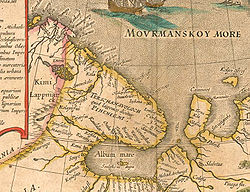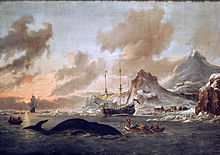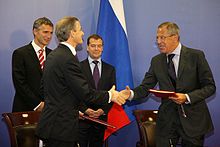Barents Sea
| Barents Sea | ||
|---|---|---|
Primary inflows Norwegian Sea, Arctic Ocean | | |
| Basin countries | Norway and Russia | |
| Surface area | 1,400,000 km2 (540,000 sq mi) | |
| Average depth | 230 m (750 ft) | |
| References | Institute of Marine Research, Norway | |
The Barents Sea (
The Barents Sea is a rather shallow shelf sea with an average depth of 230 metres (750 ft), and it is an important site for both fishing and hydrocarbon exploration.[5] It is bordered by the Kola Peninsula to the south, the shelf edge towards the Norwegian Sea to the west, the archipelagos of Svalbard to the northwest, Franz Josef Land to the northeast and Novaya Zemlya to the east. The islands of Novaya Zemlya, an extension of the northern end of the Ural Mountains, separate the Barents Sea from the Kara Sea.
Although part of the Arctic Ocean, the Barents Sea has been characterised as "turning into the
Geography

The southern half of the Barents Sea, including the ports of
There are three main types of
The lands of Novaya Zemlya attained most of their early Holocene coastal deglaciation approximately 10,000 years before the present.[8]
Extent
The International Hydrographic Organization defines the limits of the "Barentsz Sea" [sic] as follows:[9]
- On the west: The northeastern limit of the North Cape in Norway(25°45'E)].
- On the northwest: The eastern shore of West Spitzbergen [sic], Hinlopen Strait up to 80° latitude north; south and east coasts of North-East Land [the island of Nordaustlandet] to Cape Leigh Smith (80°05′N 28°00′E / 80.083°N 28.000°E).
- On the north: Cape Leigh Smith across the Islands Bolshoy Ostrov (Great Island) [Victoria; Cape Mary Harmsworth (southwestern extremity of Alexandra Land) along the northern coasts of Franz-Josef Land as far as Cape Kohlsaat (81°14′N 65°10′E / 81.233°N 65.167°E).
- On the east: Cape Kohlsaat to Cape Zhelaniya (Desire); west and southwest coast of Novaya Zemlya to Cape Kussov Noss and thence to western entrance Cape, Dolgaya Bay (70°15′N 58°25′E / 70.250°N 58.417°E) on Vaigach Island. Through Vaigach Island to Cape Greben; thence to Cape Belyi Noss on the mainland.
- On the south: The northern limit of the White Sea [A line joining Svyatoi Nos (Murmansk Coast, 39°47'E) and Cape Kanin].
Other islands in the Barents Sea include Chaichy and Timanets.
Geology
The Barents Sea was originally formed from two major continental collisions: the Caledonian orogeny, in which the Baltica and Laurentia collided to form Laurasia, and a subsequent collision between Laurasia and Western Siberia. Most of its geological history is dominated by extensional tectonics, caused by the collapse of the Caledonian and Uralian orogenic belts and the break-up of Pangaea.[10] These events created the major rift basins that dominate the Barents Shelf, along with various platforms and structural highs. The later geological history of the Barents Sea is dominated by Late Cenozoic uplift, particularly that caused by Quaternary glaciation, which has resulted in erosion and deposition of significant sediment.[11]
Ecology
Due to the
SIZEX-89 was an international winter experiment in 1989 for which the main objectives were to perform sensor signature studies of different ice types to develop SAR algorithms for ice variables, such as ice types, ice concentrations and ice kinematics.[12] Although previous research suggested that predation by whales may be the cause of depleting fish stocks, more recent research suggests that marine mammal consumption has only a trivial influence on fisheries. A model assessing the effects of fisheries and climate was far more accurate at describing trends in fish abundance.[13] There is a genetically distinct polar bear population associated with the Barents Sea.[14]
Pollution
The Barents Sea is "among the most polluted places on Earth" due to accumulated marine garbage, decades of Soviet nuclear tests, radioactive waste dumping and industrial pollution.[15] The elevated pollution has caused elevated rates of disease among locals.[15] With rising military buildup and increased use of shipping lanes heading east through the Arctic, there are concerns that a further increase in pollution is likely, not least from the increased risk of future oil spills from ships not properly equipped for the environment.[15]
Connections to global weather
Barents Sea is the fastest-warming part of the Arctic, and some assessments now treat Barents sea ice as a separate tipping point from the rest of the Arctic sea ice, suggesting that it could permanently disappear once the global warming exceeds 1.5 degrees.
History

Name
The Barents Sea was formerly known to Russians as Murmanskoye More, or the "Sea of Murmans" (i.e., their term for Norwegians). It appears with this name in sixteenth-century maps, including
This sea was given its present name by Europeans in honour of Willem Barentsz, a Dutch navigator and explorer. Barentsz was the leader of early expeditions to the far north, at the end of the sixteenth century.
The Barents Sea has been called by sailors "The Devil's Dance Floor" due to its unpredictability and difficulty level.[28]
Ocean rowers call it "Devil's Jaw". In 2017, after the first recorded complete man-powered crossing of the Barents Sea from
Modern era
Seabed mapping was completed in 1933; the first full map was produced by Russian marine geologist Maria Klenova.
The Barents Sea was the site of a notable World War II engagement which later became known as the Battle of the Barents Sea. Under the command of Oskar Kummetz, German warships sank minelayer HMS Bramble and destroyer HMS Achates but lost destroyer Z16 Friedrich Eckoldt. Also, the German cruiser Admiral Hipper was severely damaged by British gunfire. The Germans later retreated and the British convoy arrived safely at Murmansk shortly afterwards.
During the
Economy
Political status

For decades there was a boundary dispute between Norway and Russia regarding the position of the boundary between their respective claims to the Barents Sea. The Norwegians favoured a median line, based on the Geneva Convention of 1958, whereas the Russians favoured a meridian- based sector line, based on a Soviet decision of 1926.[10] A neutral "grey" zone between the competing claims had an area of 175,000 square kilometres (68,000 sq mi), which is approximately 12% of the total area of the Barents Sea. The two countries started negotiations on the location of the boundary in 1974 and agreed to a moratorium on hydrocarbon exploration in 1976.
Twenty years after the fall of the Soviet Union, in 2010 Norway and Russia signed an agreement that placed the boundary equidistant from their competing claims. This was ratified and went into force on 7 July 2011, opening the grey zone for hydrocarbon exploration.[30]
Oil and gas
Encouraged by the success of oil exploration and production in the
However, interest in the area began to wane due to a succession of dry holes, wells containing only gas (which was cheap at the time), and the prohibitive costs of developing wells in such a remote area. Interest in the area was reignited in the late 2000s after the Snovhit field was finally brought into production[32] and two new large discoveries were made.[33]
The Russians began exploration in their territory around the same time, encouraged by their success in the Timan-Pechora Basin.[10] They drilled their first wells in the early 1980s, and some very large gas fields were discovered throughout this decade. The Shtokman field was discovered in 1988 and is classed as a giant gas field: currently the 5th-largest gas field in the world. Similar practical difficulties Barents Sea resulted in a decline in Russian exploration, aggravated by the nation's political instability of the 1990s.
Fishing

The Barents Sea contains the world's largest remaining cod population,[34] as well as important stocks of haddock and capelin. Fishing is managed jointly by Russia and Norway in the form of the Joint Norwegian–Russian Fisheries Commission, established in 1976, in an attempt to keep track of how many fish are leaving the ecosystem due to fishing.[35] The Joint Norwegian-Russian Fisheries Commission sets Total Allowable Catches (TACs) for multiple species throughout their migratory tracks. Through the Commission, Norway and Russia also exchange fishing quotas and catch statistics to ensure the TACs are not being violated.
However there are problems with reporting under this system, and researchers believe that they do not have accurate data for the effects of fishing on the Barents Sea ecosystem. Cod is one of the major catches. A large portion of catches are not reported when the fishing boats land, to account for profits that are being lost to high taxes and fees. Since many fishermen do not strictly follow the TACs and rules set forth by the Commission, the amount of fish being extracted annually from the Barents Sea is underestimated.
Barents Sea biodiversity and marine bioprospecting
The Barents Sea, where temperate waters from the Gulf Stream and cold waters from the Arctic meet, is home to an enormous diversity of organisms, which are well-adapted to the extreme conditions of their marine habitats. This makes these arctic species very attractive for marine bioprospecting. Marine bioprospecting may be defined as the search for bioactive molecules and compounds from marine sources that have new, unique properties and the potential for commercial applications. Amongst others, applications include medicines, food and feed, textiles, cosmetics and the process industry.[36][37]
The Norwegian government strategically supports the development of marine bioprospecting as it has the potential to contribute to new and sustainable wealth creation. Tromsø and the northern areas of Norway play a central role in this strategy. They have excellent access to unique Arctic marine organisms, existing marine industries, and R&D competence and infrastructure in this region. Since 2007, science and industry have cooperated closely on bioprospecting and the development and commercialization of new products.[36][37]
See also
- Barents Basin
- Continental shelf of Russia
- Energy in Norway
- List of largest biotechnology & pharmaceutical companies
- List of oil and gas fields of the Barents Sea
- List of seas
Notes
- ^
Wells, John C. (2008). Longman Pronunciation Dictionary (3rd ed.). Longman. ISBN 978-1-4058-8118-0.
- ^ Berulfsen, Bjarne (1969). Norsk Uttaleordbok (in Norwegian). Oslo: H. Aschehoug & Co (W Nygaard). p. 37.
- ISBN 978-1-57958-348-4. Retrieved 29 November 2010.
- ^ World Wildlife Fund, 2008.
- ^ O. G. Austvik, 2006.
- ^ ISSN 0190-8286. Retrieved 2018-06-27.
- ^ S2CID 232765992.
- ^ J. Zeeberg, 2001.
- ^ "Limits of Oceans and Seas, 3rd edition" (PDF). International Hydrographic Organization. 1953. Archived from the original (PDF) on 8 October 2011. Retrieved 28 December 2020.
- ^ a b c d e Doré, A.G. (Sep 1995). "Barents Sea Geology, Petroleum Resources and Commercial Potential" (PDF). Arctic Institute of North America. Archived (PDF) from the original on 2006-10-29.
- ^ Doré, A.G. (March 1996). "Impact of Glaciations on Basin Evolution: Data and Models from the Norwegian Margin and Adjacent Areas". 12 (1–4). Global and Planetary Change.
{{cite journal}}: Cite journal requires|journal=(help) - ^ Sea ice modeling in the Barents Sea during SIZEX 89 (Haugan, P.M., Johannessen, O.M. and Sandven, S., IGARSS´90 symposium, Washington D.C., 1990)
- PMID 19126534.
- ^ C.M. Hogan, 2008
- ^ a b c "'Nature is being destroyed': Russia's arms buildup in Barents Sea creating toxic legacy". The Guardian.
- ^ Armstrong McKay, David (9 September 2022). "Exceeding 1.5°C global warming could trigger multiple climate tipping points – paper explainer". climatetippingpoints.info. Retrieved 2 October 2022.
- .
- S2CID 92214293.
- S2CID 126675127.
- S2CID 125312203.
- .
- S2CID 133858619.
- ^ S2CID 238716298.
- S2CID 245672460.
- S2CID 236235248.
- S2CID 251230011.
- ^ "Баренцево море: где находится, описание, история". iskatel.com (in Russian). Retrieved 2023-07-07.
- ^ Administrator, journallive (2006-08-15). "Warming to cap art". journallive. Archived from the original on 2017-10-05. Retrieved 2017-10-05.
- ^ AS, TV 2. "Tor (36) nådde Svalbard på supertid, this is the link to the news summary, full video news was broadcast on 29 July in the News section, available on youtube". TV 2 (in Norwegian). Retrieved 2017-10-05.
{{cite news}}: CS1 maint: numeric names: authors list (link) - ^ Amos, Howard (7 July 2011). "Arctic Treaty With Norway Opens Fields". The Moscow Times. Retrieved 2 July 2014.
- ^ "Snøhvit Gas Field, Norway". Offshore Technology. Retrieved 2 July 2014.
- ^ "Snøhvit". Statoil Website. Archived from the original on 1 May 2016. Retrieved 2 July 2014.
- ^ "Norway Makes Its Second Huge Oil Discovery In The Past Year". Associated Press. January 9, 2012.
a well drilled in the Havis prospect in the Barents Sea proved both oil and gas at an estimated volume of between 200 million and 300 million barrels of recoverable oil equivalents.
- World Wildlife Foundation. Retrieved 4 July 2014.
- ^ "The History of the Joint Norwegian-Russian Fisheries Commission". Archived from the original on 2014-07-14. Retrieved 2014-07-07.
- ^ PMID 24078803.
- ^ a b Nasjonal Strategi 2009. "Marin bioprospektering – en kilde til ny og bærekraftig verdiskaping" (PDF). Archived (PDF) from the original on 2014-10-28.
{{cite web}}: CS1 maint: numeric names: authors list (link)
References
- Ole Gunnar Austvik (2006) Oil and gas in the High North, Security Policy Library no. 4, The Norwegian Atlantic Committee. ISSN 0802-6602.
- C. Michael Hogan (2008) Polar Bear: Ursus maritimus, Globaltwitcher.com, ed. Nicklas Stromberg.
- World Wildlife Fund (2008). Barents Sea environment and conservation.
- Zeeberg, JaapJan; David J. Lubinski; Steven L. Forman (September 2001). "Holocene Relative Sea Level History of Novaya Zemlya, Russia and Implications for Late Weichselian Ice-Sheet Loading" (PDF). Quaternary Research. 56 (2). Quaternary Research Center/Elsevier Science: 218–230. S2CID 58938344.
External links
- . Encyclopædia Britannica. Vol. 3 (11th ed.). 1911.
- Barents.com—Developing the Barents Region
- Foraminifera of the Barents Sea—illustrated catalog
